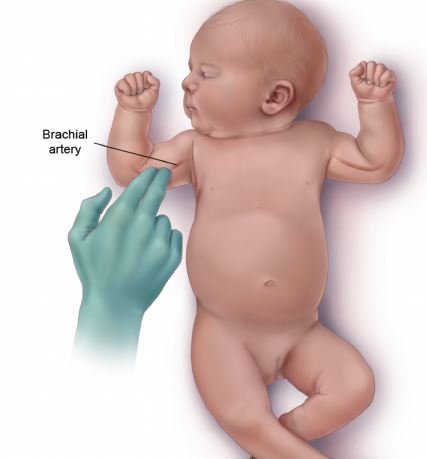The American Heart Association's guidelines for infant cardiopulmonary resuscitation (CPR) are used on children age <1 year. To check a pulse on an infant, the nurse should palpate the brachial artery by placing 2 or 3 fingers halfway between the shoulder and elbow on the medial aspect of the arm. The pulse should be assessed for 5-10 seconds to determine its presence and quality before CPR is initiated. The brachial pulse is preferred in infants as the brachial artery is close to the surface and is easily palpable. The carotid pulse can be difficult to assess due to a child's shorter neck. Extending an infant's neck to attempt to palpate the carotid pulse can cause injury. This pulse is recommended for clients age >1 year. The femoral pulse may be used for all clients; however, it is often not easily accessible for palpation due to diapers and clothing. The radial pulse is used in responsive clients age >1 year. It is not a recommended method of pulse detection in an unresponsive client as a weak or thready pulse is difficult to palpate at this location.
Educational objective: According to the infant cardiopulmonary resuscitation guidelines of the American Heart Association, the brachial artery is used to detect a pulse in an unresponsive client age <1 year.

The American Heart Association's guidelines for infant cardiopulmonary resuscitation (CPR) are used on children age <1 year. To check a pulse on an infant, the nurse should palpate the brachial artery by placing 2 or 3 fingers halfway between the shoulder and elbow on the medial aspect of the arm. The pulse should be assessed for 5-10 seconds to determine its presence and quality before CPR is initiated. The brachial pulse is preferred in infants as the brachial artery is close to the surface and is easily palpable. The carotid pulse can be difficult to assess due to a child's shorter neck. Extending an infant's neck to attempt to palpate the carotid pulse can cause injury. This pulse is recommended for clients age >1 year. The femoral pulse may be used for all clients; however, it is often not easily accessible for palpation due to diapers and clothing. The radial pulse is used in responsive clients age >1 year. It is not a recommended method of pulse detection in an unresponsive client as a weak or thready pulse is difficult to palpate at this location.
Educational objective: According to the infant cardiopulmonary resuscitation guidelines of the American Heart Association, the brachial artery is used to detect a pulse in an unresponsive client age <1 year.



![Boost Skills: NCLEX Daily Questions #12 [ays_quiz id="160"]](https://completenursingsolution.in/wp-content/uploads/2024/10/01-Nov.-NCLEX-Practice-Questions.png)
You can definitely see your enthusiasm in the work you write. The world hopes for even more passionate writers like you who are not afraid to say how they believe. Always go after your heart.
I am delighted that I detected this website, precisely the right info that I was searching for! .
Wow, incredible blog layout! How long have you been blogging for? you made blogging look easy. The overall look of your website is great, let alone the content!
Good write-up, I am normal visitor of one?¦s website, maintain up the excellent operate, and It’s going to be a regular visitor for a long time.
Excellent blog here! Also your website loads up very fast! What host are you using? Can I get your affiliate link to your host? I wish my web site loaded up as quickly as yours lol
I like the valuable info you provide in your articles. I’ll bookmark your weblog and check again here frequently. I am quite sure I’ll learn many new stuff right here! Good luck for the next!
Great info and straight to the point. I don’t know if this is really the best place to ask but do you guys have any ideea where to employ some professional writers? Thx 🙂
Loving the information on this web site, you have done great job on the posts.
I am glad to be one of many visitors on this great internet site (:, regards for putting up.